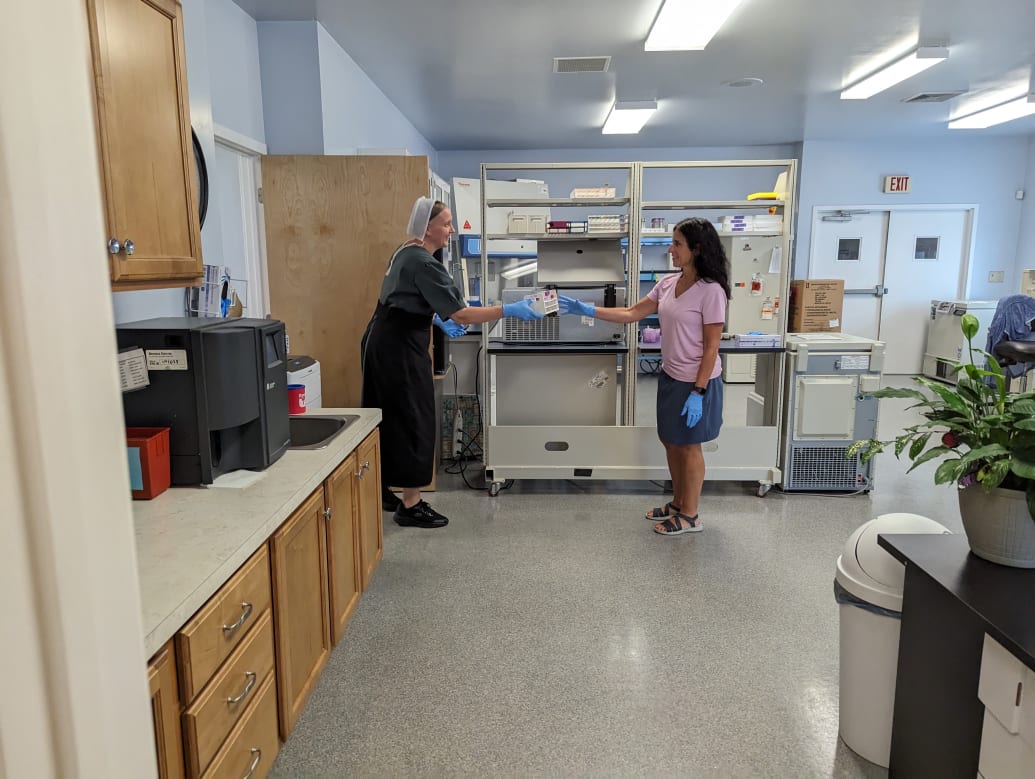The Keys to Mental Illness May Be Hiding Within Amish Genes

Researchers believe a centuries-old religious community may be able to shine a light on how we can best treat disorders like depression.

One Amish family in Lancaster, Pennsylvania, had known for some time their son was deeply troubled and unhappy. Now in his early twenties, he had not flourished, and had not found his way as a productive member of their farming community of 40,000 Old Order Amish. The family faced many barriers to address their son’s mental health.
When cases like these reach a crisis point, the Amish community provides support groups for people whose mental illness impacts their ability to function, Susan Shaub, a registered nurse and the nurse coordinator for the Amish Research Center (ARC) in Lancaster, told The Daily Beast. They assist them with finding work, usually within the community, that accommodates their functional level. They assist them with handling finances and hold benefit sales to raise money to cover expenses.
Often, these support personnel also enroll the impacted person in medical research studies related to mental health at the ARC.
“Amish family members are more likely to participate in a study if they know some of their siblings have participated,” said Shaub, who has worked at the ARC since 2004. “Those with siblings who have significant mental health issues often take part in hopes of the research leading to improved treatments.”

For nearly half a century, medical researchers working with the Amish have uncovered important breakthroughs. According to Seth Ament, a geneticist and neuroscientist at the University of Maryland School of Medicine in Baltimore, studies in the Amish have led to the discovery of many genes and genetic associations relevant to cardiometabolic traits, bipolar disorders, brain aging, and autism. One of the genetic variants enriched in the Amish population, Ament added, is associated with increased risk for long-QT syndrome, a form of heart arrhythmia that can lead to sudden death due to heart attacks, sometimes without any prior symptoms.
“What is unique in the Old Order Amish is that the burdens associated with these diseases are spread across the entire family because they are essentially one 40,000-person family,” Ament told The Daily Beast. “Because the Amish family is so large there are opportunities to develop precision medicine strategies in the Amish that may be applied in the future to the broader population.”
One recent study published in the journal Molecular Psychiatry has elevated scientists’ understanding of the genetic causes of depression, bipolar disorder, and other mental illnesses—which afflict approximately 300 million people worldwide.
“What we knew prior to our study is that genetic factors account for up to 80 percent of risk for bipolar disorder and up to 50 percent of risk for major depressive disorder,” said Ament, a co-author of that new study. “Most affected people in the general population inherit many risk variants, each of which has a very small effect. But in the Amish population, we were able to identify specific genetic variation in four chromosomal regions that double or triple someone’s risk for having a mood disorder.” These genomic changes were previously unknown to researchers.
Those revelations are the culmination of nearly a decade of work by Ament and his team, who have been analyzing genome-wide association studies of Old Order Amish patients at the university’s Amish Research Clinic. They may lead to a deeper understanding of the causes of mental health illnesses in a broader population—as well as potential targets for new drug development.
Geneticists consider this specific Amish community in Lancaster to be a “founder population,” meaning they are direct descendants from a starting community of just a few people. In this case, the Lancaster Amish hail from 400 people who immigrated to the U.S. from Western Europe (mostly of Swiss-German descent) in the late 1700s.

For religious reasons, the Amish marry only within their community, so as that original population has expanded to 40,000 in the present day, the genetic variation within the population remains primarily derived from the original 400 founders.
In other words, members of this Old Order Amish in Lancaster represent one extremely large family with about 40,000 members.
“That’s one of the interesting things about the population,” Ament said.” They are very close to us, and yet they are a very distinct group genetically and culturally.”
Because the genetic variation within this community is so narrow, there may be particular DNA variants in the genes of Amish individuals that can be more readily discovered, according to Jonathan Pevsner, chief of the National Institutes of Mental Health’s genomics research.
“The study of mood disorders in the Amish is something that we think is particularly helpful,” Pevsner told The Daily Beast. “There are other founder populations around the world that we also support the study of, but in the case of the Amish it’s been highly productive.”
Ament pointed out that the Amish who participate in the studies find the research mutually beneficial for their community, so they see the work as a two-way relationship.
“The study of mood disorders in the Amish is something that we think is particularly helpful… it’s been highly productive” — Jonathan Pevsner, National Institutes of Mental Health
“For religious reasons, the Amish don’t use some modern technologies, but they are very savvy and understand that people who are members of founder populations are at risk for certain rare disorders,” said Ament. “They also understand that their genetics are of value to the broader community, so they enroll in these studies and allow us to study their families, and the research is supported by the leaders of their parishes.”
Although the ARC was first established in 1994, Ament traced the origins of these Amish studies even further back to Victor McKusick, widely considered the “father of medical genetics.” McKusick, who died in 2008, had begun enrolling Amish patients with bipolar disorder in his genetic studies at Johns Hopkins School of Medicine back in the 1970s, uncovering the recessive gene links to several disorders. .
Ament said he was inspired by McKusick’s sensitive but focused approach to studying the Old Order Amish of Pennsylvania as a group with a relatively isolated gene pool. He realized he could employ their medical and genetic histories to quickly identify the genes responsible for their inherited physical abnormalities and disorders.

At that time, researchers didn’t know as much about the genetic architecture of disease, and there was hope that there might be a single mutation that explained mental health disorders.
“I don’t want to say our study is the culmination of Dr. McKusick’s work, but a substantial step forward in studies of mood disorders in the Amish,” said Ament. “We are making real progress to understand the mechanisms in the brain that contribute to diseases like bipolar disorder and depression that, in time, will very likely lead to more precise ways to treat those diseases.”
Shaub told The Daily Beast the clinic has always trod carefully with the topic of mental health studies in the Amish community to ensure confidentiality for anyone participating in a study. From the start, the clinic’s nurses worked closely with Amish liaisons to help open doors and recruit patients. Currently, there are 17 liaisons involved with eight active studies.
“Over the years, the community realized that even though these ladies are part of the community, they are held to our standards of HIPPA patient privacy,” she said. “People know they can be comfortable sharing things in the presence of our liaisons and it will be kept confidential.”
One of the liaisons, Lavina Ebersol, who assisted with recruiting patients for Ament’s study, told The Daily Beast: “You could tell the people who may have had mental health issues because they just sat there a little more quiet and hesitant, and the ones who might have had it in their families were a little bit more open and willing to talk about it and participate in the study to do whatever they can to help their relatives.”
While they don’t know what the end results will be because the ARC does long-term research studies, Shaub said the Amish participants see mental health issues in families generation after generation, so they want to help improve the situation for the next generation, if possible.
“The ones who might have had [mental health issues] in their families were a little bit more open and willing to talk about it and participate in the study to do whatever they can to help their relatives.” — Lavina Ebersol
She added that there may not be an immediate benefit for the patients’ mental health, but they are treated well, such as receiving breakfast when they’ve had to fast before blood tests. Each receives blood screenings to test their cholesterol levels and risk for diabetes or cardiovascular disease—“Just to give them a little piece of something for what they have done for us,” Shaub said.
The ARC is just part of a larger network of similar research centers in the Midwest. The clinic is currently developing two collaborative studies they expect to launch soon with the Das Deutsch Clinic (DDC) for Special Needs Children in Middlefield, Ohio, just east of Cleveland. One will examine genetic diversity in general populations and the other will study cardiomyopathy, according to Heng Wang, medical director for the DDC. Unlike the ARC, the DDC Clinic studies and treats patients suffering from rare genetic diseases.
“The work we do mostly focuses on monogenic disorders where a single gene is involved, while Dr. Ament’s study involves complex disorders where multiple genes play a role, often together with environmental factors,” said Wang. “Our patients, as everyone else, could have mood disorders on top of the condition they have and may benefit from his study.”
In a study published in 2011, Wang identified the gene that causes a rare congenital condition in the Amish population called glucose-galactose malabsorption. Babies and children worldwide with the disease cannot adequately absorb sugars. As a result, the unabsorbed sugars in the baby’s intestines cause severe diarrhea and dehydration that, when left untreated, can be lethal, and many babies and children died from the condition. Moreover, these babies cannot be breastfed because breast milk contains lactose—a sugar—that cannot be adequately absorbed. In collaboration with other researchers, Wang and his team determined that a simple treatment is to remove the sugars from the children’s diet or infant formula in newborns.
At the DDC, Wang said, they now diagnose two to five babies with the disease every year through DNA testing.
